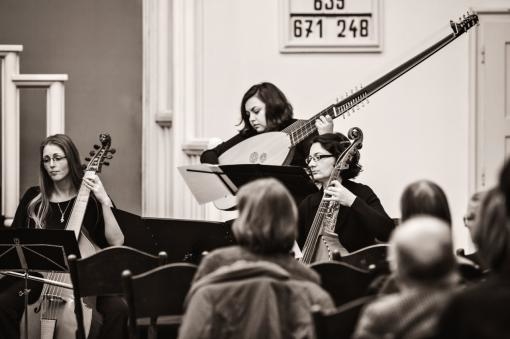In the hall of Blahoslav House (the centre for the Evangelical Church of the Czech Brethren) yesterday evening there were performances of religious works from the late Renaissance and the early Baroque by the chamber choir Ensemble Versus and the period instruments ensemble Castello in Aria. Both bodies were conducted by the artistic director Vladimír Maňas. In yesterday’s programme there were both proven works and unknown ones by rarely performed European composers.
It is not the first time that the Blahoslav House has provided a refuge for a remarkable musical achievement. It has hosted choral arrangements of carols as well as modern spiritual works. This is no surprise – the honest, strictly Christian unburdened atmosphere of the place encourages spiritual and human solidarity, without paying a heavy toll in the form of the cold alienation or rigorous inflexibility of traditional churches. However is the unscathed transfer of musical works of Renaissance masters to such a place possible without damage to the spiritual message which originally could be heard from the heights of church choirs? In the shape of the choir Ensemble Versus and the instrumental ensemble Castello in Aria it is not only possible, but the result takes the best from both worlds – the dignity of high polyphony as well as the natural simplicity of human faith.
The concert opened with an instrumental sonata by Giovanni Battista Buonamente performed by Castello in Aria. Although the evening consisted of works by various composers, plus a variable cast, it was a conceptually coherent programme of musical vespers. Instrumental and choral parts alternated. In some pieces, the two ensembles merged and expanded the dynamic range and colour of the resulting sound. In particular the use of the trombone, which in accordance with the period practice duplicated the vocal parts, was worthy of attention. The trombonist Pavel Novotný managed in the best sense to “go with the crowd”, Managing to reinforce and strengthen the carrying bass line. The instrumental parts were also a welcome enlivening of the choral polyphony, whether in the Sonata La Foscarina by the composer Biagio Marini or in the Sonata terza by Daria Castello. Especially in the last-mentioned composition the demanding and well-interpreted cornet runs by Radovan Vašina are to be commended, which fit in friendly dialogue with the strong violin of Jan Mareček. For both artists here and there appeared pitch character flaws that bubbled to the surface, mostly in parts of the songs, that is just where the two instruments could best fit in colour. Not for nothing was the cornet likened by Renaissance theorists to a human voice. The rhythmic unity of the support to the soloists was provided by the viola da gamba played by Kateřina Stávková and Anna Vargová, the theorbo of Kateřina Maňáková and the harpsichord of Víta Bébara.
The most extensive part of the programme however focused on choral compositions by late Renaissance composers. Without further ado the production can be called precise. Particularly the entries, which are often the touchstone with choirs, were managed with bewitching ease, accuracy and pure intonation. The singers skilfully kept the tones even in the higher register and maintained them in crystal clear and bright voices. Also, in terms of rhythm there is essentially nothing to criticise - Vladimir Manas had the choir under control and vigorously guarded all the entrances and held tones. As in other concerts Ensemble Versus also in this case experimented with having the singers in various dispositions, even though the venue did not offer the same possibilities as a real church. Aside from choral works by Jacob Handl Gallus, Carlo Gesualdo da Venosa and Johannes Nucius there was also a pair of works for solo voice accompanied by instruments, specifically Aus tiefer Not and All mein Anliegen by Nicolaus Zangius performed by Petra Švandová and Blanka Křížová. Švandová gave a quality performance primarily in the higher notes, where she fully projected her velvet and at the same time clearly coloured voice, while in the lower range and with quick jumps she showed a slight uncertainty of tone, which was not helped by the slightly imprecise intonation of the violin. Křížová built on playful melodies a singing part and relaxed expression, which was crowned by careful diction.
The musical vespers in this cooperation of two historically-informed ensembles offered not only a quality interpretation of works of the late Renaissance and early Baroque, but mainly spiritually strong testimony that stemmed from the naturalness, simplicity and civility of human faith. And it is in this form that faith is at its strongest and purest.
Ensemble Versus, chamber choir for religious music
Choirmaster Vladimír Maňas
Castello in Aria, association of musicians who perform Baroque music on copies of period instruments
































No comment added yet..